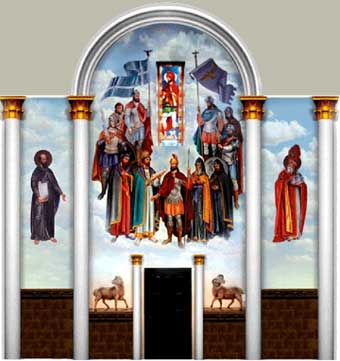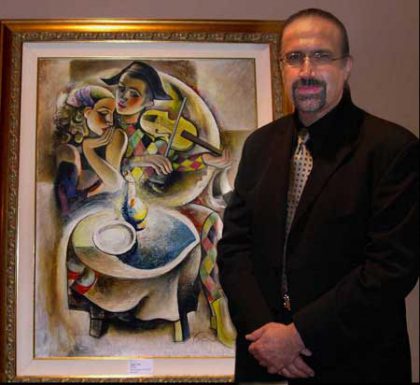
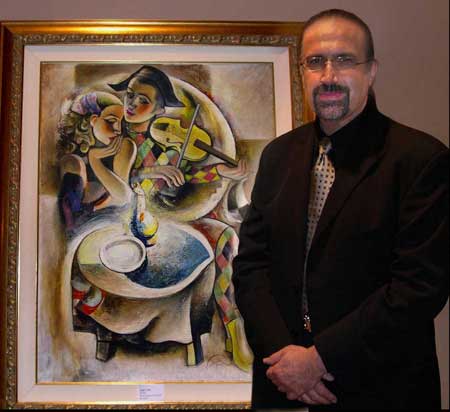 By Rosario Teixeira
By Rosario Teixeira
A retrospective of Daniel Varoujan Hejinian's art is on display now through May 2nd 2010, at the Armenian Library and Museum of America, Contemporary Art Gallery, 65 Main Street, Watertown, Massachusetts (USA). The public is invited to a reception on April 22nd from 7 pm to 9 pm.
The exhibit documents the most important aspects of Varoujan?s journey through the years, and it is comprised of Varoujan?s art work in his unique Expressionist style; it includes pieces from his Peace of Art collection which conveys a social message; and Colors of Liberty which conveys his gratitude for his adopted country. Also on display will be images of the Armenian Genocide commemorative billboards calling for the recognition of the Armenian Genocide, which he has sponsored throughout Massachusetts. Varoujan is the founder of Peace of Art, Inc., a non-profit educational organization, which promotes peaceful solutions to conflict. He's known as the painter of saints because he painted religious murals in seven Armenian churches.
On April 23rd, 2010 Varoujan will be honored at the Massachusetts State House during the commemoration of the 95th Anniversary of the Armenian Genocide sponsored by State Representative Peter Koutoujian and State Senator Steve Tolman, for his contributions to the community with his art. Since 1996, Daniel Varoujan Hejinian has been the man behind the Armenian Genocide commemorative billboards. Each year the simple message calls for recognition of the Armenian Genocide. This year's the message states “Yes, We Can Recognize the Armenian Genocide.” One digital billboard has been on display in Foxboro since early March and on April 6th today another billboard went up in Watertown. The collection may be viewed at www.PeaceofArt.org
Varoujan is the son of Armenian Genocide survivors who fled to Syria during the events that began in April 1915. Growing up, the oral family history was passed on and the genocide legacy left a deep imprint on the boy who, at a young age, already expressed his artistic creativity. “I was born in Aleppo, Syria. My parents were survivors of the massacres committed by the government of the Young Turks. They named me Daniel Varoujan, in memory of the great Armenian poet of love and peace, who was one of the first victims of the Armenian Genocide.”
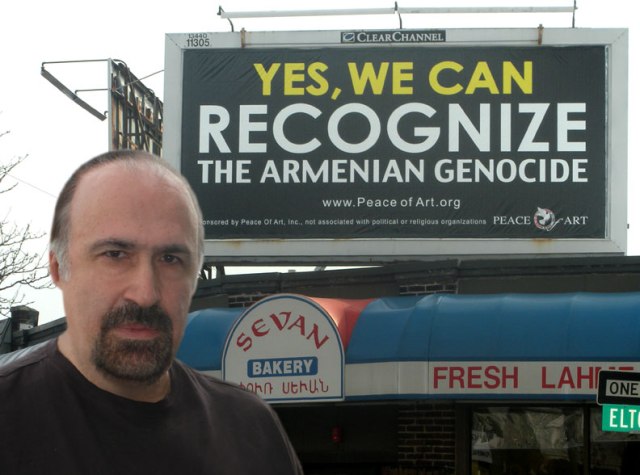 |
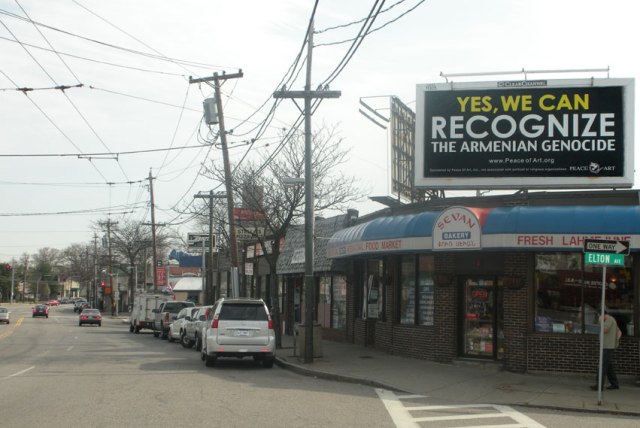 |
In 1979, he left Soviet Armenia and came to the United States. He left behind a substantial body of work which became property of the state. He made Boston his home, where he has raised a family and continued to paint and develop as an artist. Varoujan's art work has been exhibited in many prestigious art galleries throughout the United States and it is represented in private and corporate collections around the world. He's recognized as an international artist, his art is not confined to country or time. However, Varoujan has remained close to his Armenian heritage. Varoujan has been honored and has received several awards for his contributions to the community and for his artistic achievements.
The exhibit ?Varoujan's Art, a Journey through the Years,? allows the viewer to take a glimpse at the artist's itinerary, how he uses his talent to make sense of the world, reinvent it, and then propose new possibilities. Varoujan reveals the best of one's dreams through his musical notes and symphonies of color on his canvases. As an artist he's timeless, as a man he's well aware of society's struggles and realities.
He's represented by Collectors Palette and his art work can be viewed at www.collectorspalette.com.
Please contact here for more information.
Proceeds from the sale of the art work will benefit PEACE of ART, Inc. a non-profit organization. The objecive of Peace of Art, Inc., is to use art as an educational tool to bring awareness to the universal human condition through art and promote peaceful solutions to conflict.
See Varoujan's paintings here.
Gentle Touch by Varoujan (36″ x36″, oil & acrylic on canvas)
Biography of Daniel Varoujan Hejinian
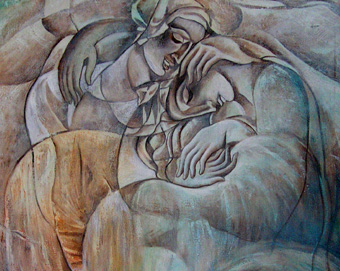
Varoujan about himself
All my life I have driven by art, music, and poetry.
The inspiration for my art is women. women create life … the highest art form!
Women are the mothers… daughters…sisters… and lovers.
The woman in my paintings are spinners of dreams. they are gentle yet strong, passionate and compassionate.
My inspiration for music comes from my father who played any instrument that he touched.
I write poetry, most often I dash to the easel to put the words down on canvas.
My philosophy…
I view my life as a symphony with both high and low notes. When I hit the low notes, I know that they are only part of the musical composition and they're going to pass. When I hit the high notes, I am always careful not to be blinded. The way I see things is always in perspective and in contrast. When there is light there's supposed to be a shadow. Shadows are created by light.
Varoujan's Murals
St. Vartanantz Armenian Apostolic Church in Chelmsford, Massachusetts
Varoujan completed 46 murals covering the northern and southern walls of St. Vartanantz Church. These paintings include apostles, holy fathers of the Armenian Church, saints, and Dominical feasts.
Varoujan took great pains in executing these murals, conducting serious dialogues and extensive research to resolve questions concerning vestments, compositions and style as affected by doctrinal prescriptions.The artist expressed the linearity of eastern-style iconographic art, yet used vivid colors. He stayed true to ancient mural-art tradition in Armenia and the Byzantine period, although preserving classic form and compositions with subtle shading. He developed great expressiveness in the tufts and drapes of vestments.
In complete departure from the ceramic look of the traditional iconography, Varoujan renders real life features in portrait style. “The faithful can communicate with these saints who profess a real personality, as opposed to simple graphic representations,” he said.
The monastery-like church has hosted thousands of passers-by from the north and the south and vacationers from the West coast and the Mid-West. Many have made the “side-trip” to see the murals and expressed their amazement at the depth of feeling and communication seen in the eyes of the saints.
A dream world of beauty where the sublime sentiments of love, joy and harmony expand themselves into all areas of one's life in this created universe.
